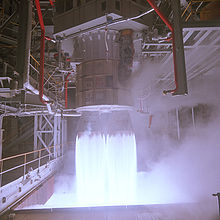Rus-M
Rus-M ( Russian Русь-М ) was a project for a new Russian launcher . The Rus-M was developed by ZSKB-Progress and was supposed to replace the Soyuz as a carrier for manned spaceships. The missile was ultimately not built.
Development history
A new, more powerful rocket for the manned Russian space flight had become necessary because the new, larger spacecraft PPTS was to be put into service. In the spring of 2009, ZSKB-Progress won the contract for the development of Rus-M and was due to submit the preliminary design by August 2010. The Rus-M as the direct Soyuz successor was in competition with the planned Proton successor Angara . From a political point of view, this was definitely wanted, since otherwise manned Russian space travel would only have committed itself to one rocket and thus only one manufacturer.
In October 2011, Vladimir Popovkin , the head of the Russian Space Agency, announced that development of the Rus-M would be discontinued. Instead, the focus was initially on completing the Angara, before a new project for a Soyuz successor called Soyuz-5 was launched in the mid-2010s .
technology
In its basic version, the Rus-M was supposed to bring a payload of 23.8 t into a 200 km LEO and 18.8 t in a manned mission in a 135 to 440 km orbit. These payloads were located significantly higher than those of the Soyuz rocket previously used. The basic version of the rocket consisted of three boosters and an upper stage. The three boosters, one of which was the central stage, had the same structure. The upper level was attached to the middle booster. Proven technology was used to propel the rocket. Each booster should be in a 180-RD -Triebwerk RP-1 and liquid oxygen burn. The three engines were supposed to generate a total of 1016 t of thrust. The second stage relied on the high-energy fuel combination of liquid oxygen and liquid hydrogen ( LOX / LH2). This should be burned in four RD-0146 engines and generate 40 t of thrust.
Versions
| version | booster | Upper school | Maximum payload | ||
|---|---|---|---|---|---|
| LEO 200 km | LEO manned | GTO | |||
| Rus-M 1 | 3 | four RD-0146 | 23.8 t | 18.8 t | 7 t |
| Rus-M 2 | 5 | four RD-0146 | 35 t | ? | ? |
| Rus-M 3 | 5 | four RD-0146 | 50 t | ? | ? |
| Rus-M 4 | ? | ? | 130-150 tons | ? | ? |
Other rocket versions have been announced on the Russian Space Agency website. However, more precise data was not provided. The second variant of the Rus-M had a total of five engines in the first stage and was supposed to transport 35 t in a 200 km LEO. The third version also used five boosters in the first stage, but these were extended. This version should transport 50 t in a 200 km LEO. When the rocket was officially launched in October 2009, a super heavy version of the rocket was also announced. This should transport 130 - 150 t in a 200 km LEO. It should also be possible to implement this version with the same components. However, possibilities were also discussed to use LH2 and LOX or even 3-component fuels (Triergol) in all stages . However, exact information about this version was not given.
Web links
- RUS-M launch vehicle in the Russian Space Web
Individual evidence
- ↑ Anatoly Zak: Russia Reveals Vision for Manned Spaceflight . IEEE Spectrum. August 20, 2009. Retrieved February 9, 2010.
- ^ Replacement for Soyuz rocket canned by Russia , Spaceflight Now. October 7, 2011.
